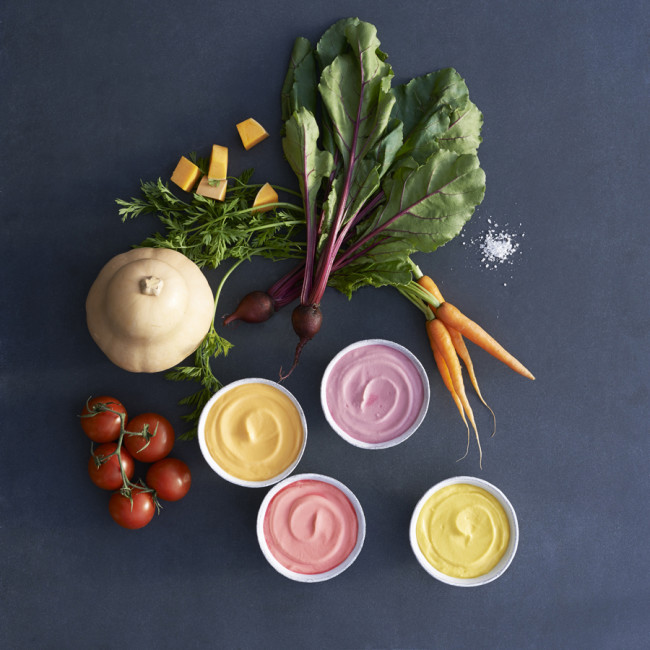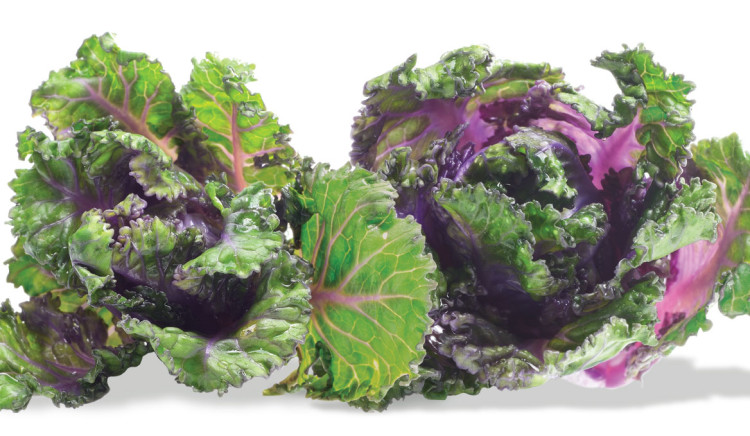
Blue Hill Farm’s yoghurts made with vegetables
Roast cauliflower, Peruvian quinoa and avocado on sourdough toast were super popular in 2015, but what and where will we be eating in 2016? We predict the hottest new trends from flower sprouts and single-dish restaurants to a revival for shared family meals and craft soda fountains.
Savoury yoghurt: In 2016 savoury is the new sweet. Well, we’ve been chucking kale, spinach and carrots into the Nutribullet for the past year or two so it was only really a matter of time before veggies started to show up in yoghurts. The growing popularity of beetroot, parsnip and butternut squash yoghurts from New York’s in-vogue Blue Hill Farm reflects a demand for fewer sweeter treats as well as a budding interest in the Middle Eastern yoghurt-cheese, labneh, which pairs well with olives, seeds and raw vegetables.
Craft soda: Soft drinks are headed the way of craft beer and gourmet burgers. In other words they are being re-mixed for grown-ups. While the mass-market soft drinks industry is suffering as a result of anti-sugar campaigns our thirst for old-fashioned drinks, made simply from natural syrups combined with carbonated water, is only growing. Using raw cane sugar, few if any shelf-life preservatives and locally sourced plant-based ingredients and spices the likes of root beer made with maple syrup, vanilla-flavoured cream sodas and black cherry fizz appeal to both nostalgic parents and Millennials seeking an alternative to alcopops. Check out Hamilton’s Soda Fountain and Luncheonette in New York’s Greenwich Village for the real deal.
“Single dish” restaurants: Overwhelmed by having to wade through menus as long as a novel when you go out to eat? Fear not, the trend for “single order” restaurants is growing. Basically it boils down to serving one item really well. It could be gourmet hot dogs, hip houmous, posh cheese toasties or retro cereals. It’s a natural bricks-and-mortar extension of the food truck trend, and it certainly saves time on those tricky menu decisions.
Sub-Saharan African food: In recent years Middle Eastern and North African cuisines have been among the hottest trends in restaurants and cookbooks, but south of the Sahara is a whole new food world to discover. Leading the charge for African cookery is a trendy young trio of lads from southeast London who run the Groundnut supper club. On the menu: pounded yam, okra soup, palm nut with beef stew, and Ethiopian teff, a contender for quinoa’s crown as the next big highly nutritious and gluten-free ancient grain. Teff can be served as porridge with raisins and honey or made into pancakes or flatbread for savoury dishes. Watch out, too, for baobab fruit, long considered a potent elixir in Africa. It is sold in powdered form, has six times the vitamin C of oranges and six times the potassium of bananas and is increasingly found in exotic fruit juices.

Flower sprouts are the new kale
Brussels sprouts and Flower Sprouts: Has kale finally been kicked in to touch? Yes, is the answer from trendsetting chefs across the UK who are serving up Brussels sprouts as their side dish du jour. The much maligned Christmas day staple is packed with folic acid and vitamins C and K and is versatile whether roasted in a balsamic glaze or steamed and served with butter and chives. If you’re not ready to give up kale just yet then Flower Sprouts or kalettes as they’re known in the US – mini cabbages with frilly green and purple streaked leaves from a Brussels and kale mash-up – may be just the bridging bite for you.
Golden berries: Also known as Cape gooseberries, Aztec berries, ground cherry and various other names, it’s hard to become a headline trend when you haven’t really decided on a single catchy name yet. But reports from American fruit buyers suggest that the Latin American golden berry is set to topple the blueberry as the ultimate superfood. Familiar to some British shoppers as physalis, this cherry-sized, amber-coloured fruit comes wrapped in a papery casing. It has a sweet-sour taste and can be eaten fresh or as a sun-dried version.
Bone broth: It may sound like an unlikely coffee substitute for fashionable folk but this thin, meaty stock has become the preferred hot drink of Fitbit wearing health fanatics in LA and New York. Broth is made with chicken, beef or lamb bones simmered for up to 24 hours. A small cup is packed with protein, calcium and more flavour than a mug of Bovril. British bone broth is now served at newly opened outlets in London and Brighton.
Goat: No longer the preserve of hidden-away ethnic eateries, goat meat – I kid you not – is cropping up more frequently on restaurant menus. It is lower in cholesterol and saturated fat than other red meats, yet just as tasty – it is often compared to lamb and venison for its flavour. What’s more there are plenty of cheap braising cuts. A slowly braised shoulder produces a sticky, pulled-meat treat, while the leg roasts beautifully, studded with garlic and rosemary and wrapped in foil with a splash of wine.
Seaweed: We’ve been eating foraged “weeds” such as rocket and sorrel from the land for years now so it was only a matter of time before we followed the long-living Japanese and looked to the sea’s rich harvest. Jamie Oliver flagged up this “superfood” as a key part of his successful diet in 2015 and, unsurprisingly, sales began to soar. The celebrity chef reckons that in ten years’ time, we’ll all be eating seaweed. There are many different types of seaweed, or sea vegetables, but the most popular tend to be dulse, wakame, sea spaghetti, kelp and nori. They add that elusive umami flavour and, depending on how they are cooked, a crispy or velvety texture to salads, soups and stir fries. Surely both Jamie and the Japanese can’t be wrong.

Golden spice: it’s time for turmeric
Turmeric: This golden Asian spice is best known for its digestive and anti-inflammatory properties in Indian medicine but has a whole host of culinary uses, too, beyond curry and rice. Lately it has been making an appearance in everything from desserts to cocktails where it adds a subtle, warm peppery flavour that stops short of the fiery heat of chilli. Use it to brighten the look and taste of egg-based dishes, sprinkle over roasted vegetables, especially cauliflower, or add to smoothies and oatmeal in the morning.
Sugar-free: Sugar got a bashing in 2015, primarily for its bad effect on our health, and it’s not going to get any easier for the sweet stuff. Celebrity chef Jamie Oliver has shifted his considerable clout behind a new campaign lobbying for a 20 per cent tax on fizzy drinks – a typical 330ml can contains about nine teaspoons of sugar – and judging by his latest budget, the chancellor, George Osborne, seems to agree. As a result expect to see a rise in demand for more natural alternatives to refined sugar such as raw honey, date nectar and maple syrup.
YouTube chefs: Fed up with the same old celebrity chefs on TV? Sift through the junk on YouTube’s food channel – one Japanese show features a cooking poodle while another tackles recipes when sozzled – to find a whole host of exciting new culinary talent, from the boy-band style antics of the Sorted crew to the family-centric sisters from Crumbs Food.
Cod: Oyster bars are springing up in London and beyond but the big seafood comeback of 2016 is set to be cod after the British fish supper favourite is back on the menu. Restrictions on fishing for cod in the North Sea have been lifted for the first time since 1983 and the Marine Conservation Society suggests we eat it as an occasional treat while stocks fully recover.
Korean: What with kimchi (a super healthy fermented cabbage side dish) hitting the mainstream this year, Korean cuisine is set to follow. Flying the flag is a bunch of Korean street food traders, including Choi Boys, Busan BBQ and Kimchi Cult, and London’s very own K-Town cluster of Korean restaurants in New Malden. The food is tangy and spicy and features wood grilled meats and smoky barbecue flavours. A good starter for Korean food virgins is a bulgogi burrito stuffed with grilled beef in a gochujang marinade, a sweet red chilli pepper sauce also used as a condiment, or try KFC (Korean Fried Chicken) with a side of kimchi or mooli white radish slaw.

Holey spirit: Crosstown’s designer doughnuts
Doughnuts: The doughnut has come a long way from its sugar coated, cheap jam filled days. Gourmet doughnuts are now baked pillowy fresh instead of fried so they have more of a cake-like texture. These holey treats are often made with an in-house sourdough and a whole range of homemade sweet and savoury fillings and toppings such as lemon curd and bacon and maple syrup. In fact they’re fast becoming as popular as a dinnertime dessert served with ice cream as they are a coffee-and-commuter snack. Look out for Nutella doughnuts known as donutellas – one can just picture Mary Berry licking her lips – and Kiwi chef Peter Gordon’s Crosstown doughnuts on demand.
Family meals: According to a recent report [by Waitrose], the ability to watch shows on-demand at any time has made it easier for families to forsake TV dinners and sit down to break bread together at supper time. Shared family meals are also much more likely to be an informal affair now than they were in years gone by and are increasingly eaten together in the kitchen rather than the dining room. A recent survey by the Soil Association showed that many popular restaurants are still failing to serve fresh food or healthy choices to children – another good reason to eat en famille at home.
